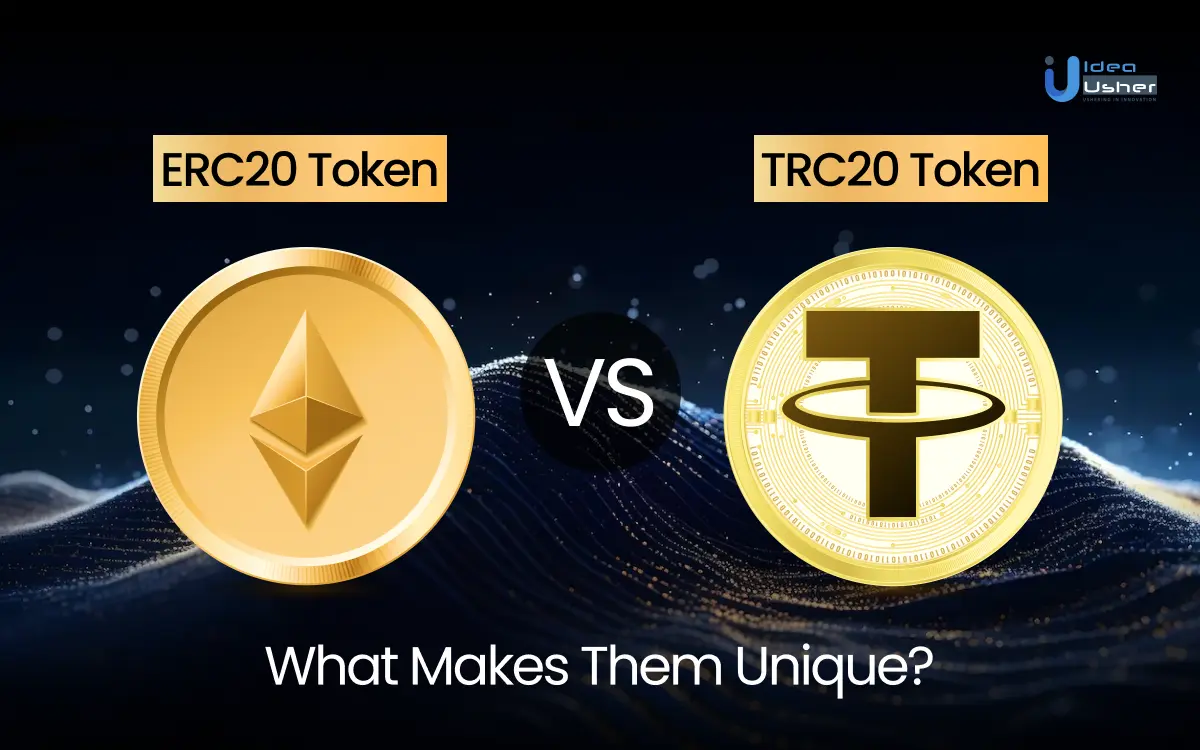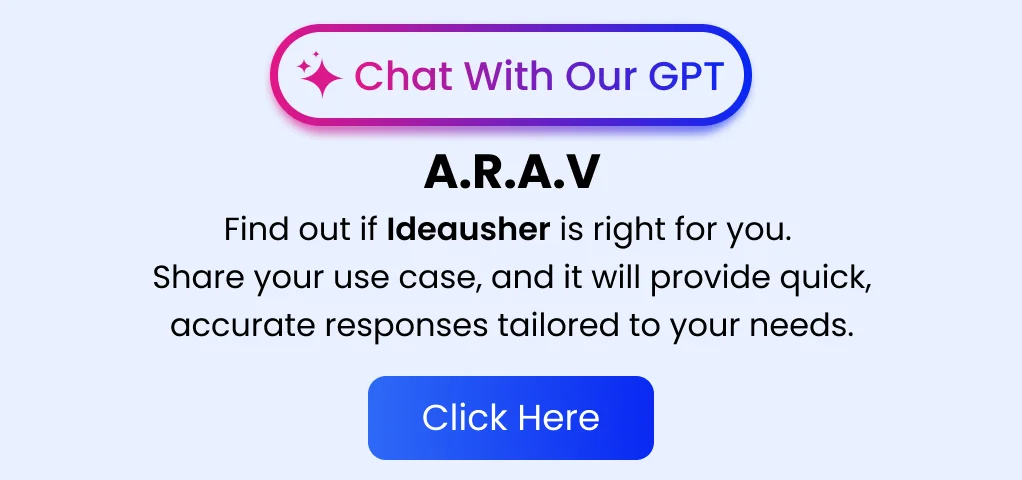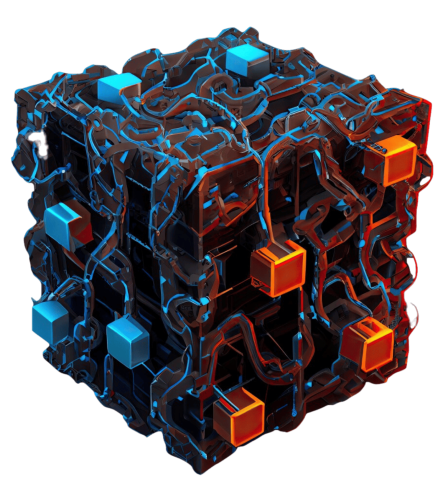ERC20 and TRC20 are the two dominant token standards for creating and deploying tokens on blockchains. ERC20 tokens reside on the Ethereum blockchain, while TRC20 tokens run on the TRON blockchain. Each boasts distinct characteristics that influence factors like transaction speed, cost, and security.
For businesses venturing into the world of token creation, selecting the right standard is crucial. This blog dives into the key characteristics of both ERC20 and TRC20 tokens, outlining the factors that make them unique and guiding your business toward the optimal choice for its specific requirements.
Understanding Token Standards
Token standards serve as foundational guidelines within the blockchain segment, dictating the structure and behavior of digital assets. It is important to comprehend these standards to navigate the intricacy of token creation and deployment.
What Is A Token Standard?
A token standard comprises a predefined set of rules governing the behavior and characteristics of digital tokens within a specific blockchain ecosystem. These standards ensure uniformity and seamless interaction among tokens, facilitating their integration into decentralized applications (DApps) and exchanges.
For example, the ERC20 token standard, powered by Ethereum, establishes a comprehensive framework for the creation and management of tokens on its blockchain. Tokens adhering to the ERC20 standard exhibit common properties and functionalities, enabling seamless integration with existing Ethereum-based infrastructure.
Different Token Standards
While Ethereum leads the ERC20 standard, other blockchain platforms have devised their own standards customized to varying use cases and requirements. These standards vary in design, functionality, and compatibility with their respective ecosystems.
Ethereum boasts several token standards, including ERC10, ERC20, and ERC721, each catering to specific needs such as fungibility, non-fungibility, or unique token attributes.
Additionally, prominent platforms like TRON and Binance Smart Chain (BSC) have introduced their token standards, namely TRC20 and BEP20, respectively. These standards offer developers alternative frameworks for token creation and management aligned with the unique features of their respective blockchains.
The Significance Of ERC20 And TRC20 Tokens
Among the various token standards, ERC20 and TRC20 tokens emerge as fundamental pillars of the crypto world.
ERC20 Tokens
ERC20 tokens are fundamental to Ethereum’s framework, offering a reliable and enduring standard for digital assets. Developed through Ethereum’s smart contracts, these tokens adhere to a set of rules governing their behavior. These rules cover vital aspects like total token supply, transfer protocols, and account balances, ensuring consistency and compatibility across Ethereum-based platforms.
Beyond their technicalities, ERC20 tokens boast several advantages. They seamlessly integrate with various wallets and decentralized exchanges, enabling effortless token transfers and exchanges. Moreover, their smart contract functionality facilitates the creation of decentralized applications, enhancing Ethereum’s utility and versatility.
TRC20 Tokens
Conversely, TRC20 tokens play a crucial role in the TRON blockchain ecosystem, embodying innovation and accessibility. Governed by the TRC20 standard, these tokens adhere to a structured framework for creation and management. Developed with TRON’s official development kit, TRC20 tokens benefit from streamlined processes and comprehensive tools.
Operating within TRC20 guidelines, tokens on the TRON network leverage enhanced functionality and interoperability. Key aspects like total supply, balance management, and transfer protocols are meticulously regulated, ensuring seamless token operations within the TRON ecosystem. Leveraging TRON’s infrastructure, TRC20 tokens have emerged as compelling alternatives, particularly for projects prioritizing scalability and rapid transaction processing.
What Makes ERC20 Tokens And TRC20 Stand Out?
ERC20 and TRC20 are both standards for creating and managing tokens on their respective blockchain networks, but they have notable distinctions.
ERC20, abbreviated from Ethereum Request for Comments 20, serves as a technical protocol for smart contracts within the Ethereum blockchain network. It establishes a set of guidelines that all Ethereum tokens must follow, ensuring seamless interactions between newly created tokens and existing smart contracts. Typically, ERC20 tokens require approximately 15 minutes to complete processing.
On the other hand, TRC20, abbreviated from TRON Request for Comment 20, is a technical standard devised for smart contracts operating on the TRON blockchain. It simplifies the creation of tokens that users can transact within the TRON network. Unlike its precursor, TRC10, TRC20 utilizes the TRON Virtual Machine (TVM), which enhances functionality for token development. TRC20 tokens are characterized by substantially lower transaction fees compared to ERC20 tokens, attributed to the inherently lower fees on the Tron network. Transactions involving TRC20 tokens can be executed within minutes, often taking less than 3 minutes.
Despite the benefits of TRC20 tokens, ERC20 tokens maintain widespread adoption due to their established presence and broader range of features.
Crypto Market Overview
In early 2023, the combined market capitalization of cryptocurrencies experienced a notable uptick, bouncing back from a decline in November 2022 that was attributed to FTX. However, this resurgence proved to be short-lived, as market uncertainty surrounding a potential recession led to a subsequent decline in the summer of 2023.
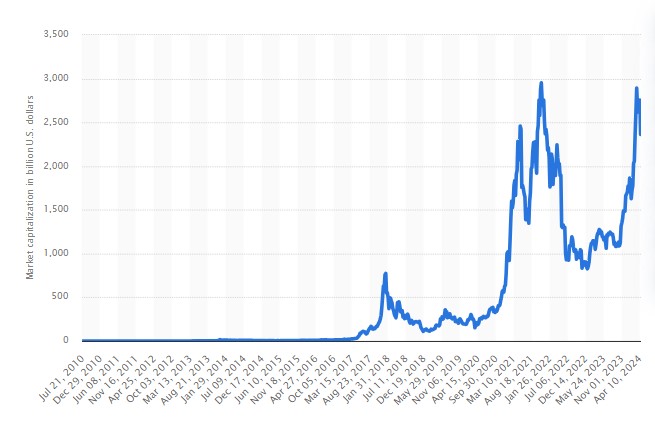
Throughout this period, Bitcoin maintained its dominance in market capitalization. Notably, Nigeria emerged as the country with the highest crypto ownership, while the United States led in Bitcoin ATMs, and Slovenia topped the list for crypto payments.
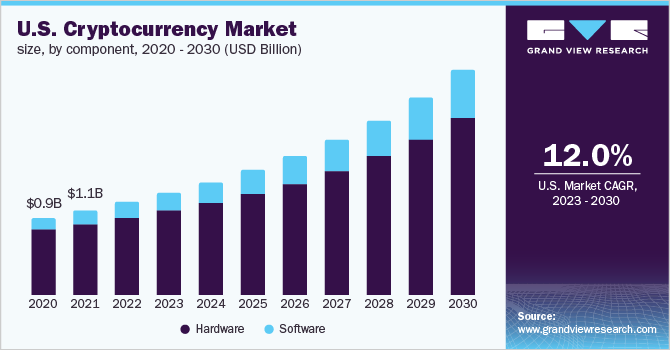
Additionally, recent developments suggest a promising outlook for the global cryptocurrency market, with projections indicating a Compound Annual Growth Rate (CAGR) of 12.5% from 2023 to 2030. Furthermore, the increasing prominence of Artificial Intelligence (AI) in cryptocurrency platforms is expected to drive significant advancements, prompting heightened focus from businesses on AI-based cryptocurrency technologies.
ERC20 vs. TRC20: A Comprehensive Analysis
The world of blockchain technology is brimming with innovation, and a crucial part of this innovation is the creation of tokens. When it comes to token development, Two of the most prominent standards are ERC20 and TRC20, each with its own advantages and target use cases. Choosing the right standard hinges on understanding the underlying blockchain platform and its capabilities.
1. Comparing Blockchain Platforms
Blockchain platforms serve as the foundation upon which tokens are built. Each platform offers unique features, functionalities, and limitations. By comparing platforms like Ethereum (ERC20) and TRON (TRC20), you can make informed decisions about factors like security, scalability, and community support. This comparison aids in understanding how well a system can handle increasing workloads.
While both Ethereum and TRON facilitate token creation, they cater to different needs.
1.1. Ethereum:
It is renowned for its robust security and established developer ecosystem. Ethereum’s Proof-of-Work consensus mechanism ensures high levels of security, making it ideal for high-value tokens or projects requiring unwavering trust. However, Ethereum can suffer from scalability issues and higher transaction fees.
1.2. TRON:
TRON prioritizes speed and affordability. It utilizes a Delegated Proof-of-Stake (DPoS) consensus mechanism, enabling faster transaction speeds and significantly lower fees compared to Ethereum. This makes TRON attractive for high-volume, low-value transactions or projects prioritizing rapid and cost-effective operations. However, TRON’s younger age translates to a less mature ecosystem and potentially lower security compared to Ethereum.
2. Token Issuance And Smart Contract Compatibility
The issuance of tokens and compatibility with smart contracts are important components of blockchain technology. Tokens have the ability to represent diverse assets, while smart contracts facilitate the automatic execution of predefined rules and conditions. Analyzing these aspects across various platforms helps in comprehending their strengths and limitations.
2.1. ERC20:
This offers a well-defined and widely adopted standard. Existing tools and templates simplify ERC20 token creation, making it a more familiar and potentially quicker process for developers. However, deploying ERC20 tokens often involves higher development costs due to Ethereum’s gas fees.
2.2. TRC20:
TRC20 provides a relatively straightforward issuance process with minimal fees. TRON’s user-friendly interface further streamlines token creation. However, the TRC20 standard is still evolving, and developer tools may not be as readily available compared to ERC20.
3. Transaction Speed, Cost, And Scalability
Transaction speed, cost, and scalability are fundamental factors in evaluating the performance of a blockchain network. A higher throughput leads to enhanced scalability. A comparative assessment of these factors across different platforms offers insights into their efficiency and suitability for various applications.
3.1. ERC20:
Ethereum’s Proof-of-Work mechanism can result in slower transaction processing times, particularly during times of increased network congestion, and the gas fees on the Ethereum network can be significant. Despite the emergence of layer-2 scaling solutions, scalability remains a challenge for ERC20 tokens.
3.2. TRC20:
TRON boasts significantly faster transaction processing times and negligible fees compared to Ethereum. This makes TRC20 ideal for applications requiring frequent, low-value transactions. However, TRON’s scalability is still under development, and its long-term viability in handling massive transaction volumes remains to be seen.
4. Community And Development Support
Community engagement and development support are integral to the success and sustainability of any project. Assessing the level of community involvement and development support across different platforms provides valuable insights into their respective merits and drawbacks, aiding in the selection of the most suitable platform.
4.1. ERC20:
ERC20 tokens benefit from a vast and well-established developer community, ensuring numerous resources, tutorials, and development tools are readily accessible. The established nature of the Ethereum ecosystem encourages greater collaboration and innovation among developers.
4.2. TRC20:
TRC20 tokens enjoy the support of a growing developer community within the TRON ecosystem. While not as extensive as Ethereum’s, TRON’s developer community actively develops tools and resources for TRC20 tokens. However, due to the relative youth of the TRON ecosystem, support may not yet be as comprehensive as that available for ERC20 tokens.
| Feature | ERC20 | TRC20 |
| Blockchain Platform | Ethereum | TRON |
| Consensus Mechanism | Proof-of-Work (PoW) | Delegated Proof-of-Stake (DPoS) |
| Security | High | Moderate (developing) |
| Transaction Speed | Slower (during peak usage) | Faster |
| Transaction Cost (Gas Fees) | ERC20 tokens have higher transaction fees due to the higher fees on the Ethereum network | TRC20 tokens have significantly lower transaction fees because the Tron network’s transaction fees are much lower |
| Scalability | Limited (ongoing development) | Potentially higher (DPoS model) |
| Token Issuance Ease | Established and well-documented | Simpler and faster |
| Smart Contract Compatibility | Widely adopted by development tools | Evolving, may require additional development |
| Smart Contract Functionality | ERC20 tokens are used in smart contracts on the Ethereum network. | TRC20 tokens enable developers to automate tasks in smart contracts on the Tron network to execute specific tasks automatically without human intervention. |
| Community & Ecosystem Support | Vast and established developer community | Growing community, ecosystem under development |
| Exchange & Wallet Adoption | Widely adopted by most major exchanges and wallets | Adoption growing, but may not be universally supported yet |
| Adoption | ERC20 tokens are more established and widely adopted, offering a more extensive range of features. | Despite the advantages of TRC20 tokens, they are not as widely adopted as ERC20 tokens. |
| Use Cases | ERC20 tokens are used in various applications like Stablecoins, Governance Tokens, Utility Tokens, Rewards Programs, and Initial Coin Offerings (ICOs). | TRC20 tokens are used in various applications within the TRON blockchain ecosystem. |
Features Of ERC20 And TRC20 Tokens
Here are the distinguishing characteristics and functionalities of ERC20 and TRC20 tokens with similarities and key differences:
1. Top 12 Key Features Of ERC 20 Tokens
Here are the fundamental characteristics that define ERC20 tokens and their significance in the digital landscape:
1.1. Standardized Functionality:
ERC20 tokens boast a uniform set of functions meticulously designed to facilitate seamless interaction with smart contracts and other tokens across the Ethereum network. These functions include totalSupply(), balanceOf(address _owner), transfer(address _to, uint256 _value), transferFrom(address _from, address _to, uint256 _value), approve(address _spender, uint256 _value), and allowance(address _owner, address _spender).
1.2. Fungibility:
ERC20 tokens boost the principle of fungibility, ensuring each token’s interchangeable nature with others of the same type and value. This characteristic enhances liquidity and simplifies token trading, fostering a dynamic ecosystem.
1.3. Interoperability:
Standardization within the ERC20 framework promotes interoperability, allowing tokens to seamlessly integrate with various applications, wallets, and smart contracts across the Ethereum network. This interoperability fosters ecosystem growth and facilitates innovative token use cases.
1.4. Simplified Token Creation:
The ERC20 standard streamlines the process of token creation on Ethereum, empowering developers to effortlessly launch new tokens with predefined functionalities. This simplification encourages diversity and innovation within the token ecosystem.
1.5. Enhanced Market Access:
ERC20 tokens have widespread adoption and accessibility due to their compatibility with leading cryptocurrency exchanges and trading platforms. This broad market access enhances token liquidity and encourages broader investor participation.
1.6. Versatile Utility:
Beyond traditional applications, ERC20 tokens find utility across various domains, including Initial Coin Offerings (ICOs), decentralized finance (DeFi), digital asset management, and tokenized asset representation. This versatility enables developers to implement custom functionalities tailored to specific use cases and user requirements.
1.7. Fractional Divisibility:
ERC20 tokens possess the capability to be divided into smaller units, enabling greater adaptability in transactions and representation of minute denominations, enhancing flexibility and precision in token transactions.
1.8. Scriptability:
Smart contracts, coded in Solidity, govern the behavior of ERC20 tokens, allowing for the development of intricate token models with distinctive attributes beyond the standardized functionalities. This scriptability enables the implementation of advanced features and custom functionalities tailored to specific use cases.
1.9. Enhanced Transparency:
The prescribed functions of ERC20 tokens foster clarity, delineating their actions and interactions within the Ethereum blockchain. This transparency empowers users and developers to comprehend and anticipate token behavior, enhancing trust and confidence in the ecosystem.
1.10. Smart Contract Implementation:
ERC20 tokens are implemented as smart contracts on the Ethereum blockchain, defining the rules and functions that the token must adhere to. This implementation ensures consistency and security in token operations.
1.11. Security And Standardization:
The ERC20 standard promotes security by providing a standardized set of rules for token development, reducing the risk of vulnerabilities, and ensuring consistency across different tokens. This standardization enhances trust and reliability in token transactions.
1.12. Token Creation And Deployment:
Developers can create and deploy ERC20 tokens relatively easily by following the standard, contributing to the widespread adoption of this token standard for ICOs, token sales, and various decentralized applications. This accessibility promotes innovation and diversity within the token ecosystem.
ERC20 and TRC20 tokens share some similarities, and they also have distinct features due to the different blockchain platforms on which they are built (Ethereum for ERC20 and TRON for TRC20). Here’s is the breakdown of the key similarities and differences:
2. Similarities Between ERC20 And TRC20 Features:
2.1. Standardized Functionality:
Both ERC20 and TRC20 token standards establish a common set of functions that tokens must comply with. This standardization facilitates interoperability with various wallets and exchanges, ensuring seamless integration within the respective blockchain ecosystems.
2.2. Fungibility:
Both ERC20 and TRC20 tokens exhibit fungibility, wherein each token is indistinguishable and interchangeable with others of the same type. This characteristic enhances liquidity and simplifies token trading across platforms.
2.3. Divisibility:
Both ERC20 and TRC20 tokens share the trait of divisibility, allowing them to be subdivided into smaller units. This feature enhances transaction flexibility and accommodates transactions involving fractional amounts of tokens.
2.4. Smart Contract Based:
Both token standards rely on smart contracts for token creation and management. Smart contracts enable the execution of predefined functionalities and the implementation of custom features, thereby enhancing the versatility of the tokens.
2.5. Solidity Development:
Developers for both ERC20 and TRC20 tokens utilize Solidity, a programming language specifically designed for writing smart contracts on the Ethereum and Tron blockchains, respectively. This commonality in development language provides a degree of familiarity and streamlines the development process for token creators.
3. Key Differences Between ERC20 And TRC20 Features:
This table highlights the key similarities and differences between ERC20 and TRC20 tokens:
| Feature | ERC20 Tokens | TRC20 Tokens |
| Blockchain Platform | Ethereum | TRON |
| Transaction Speed | Slower (especially during peak usage) | Faster |
| Transaction Fees | Higher (gas fees on Ethereum) | Lower |
| Development Complexity | More complex deployment process | Simpler deployment process |
| Ecosystem Maturity | Established and vast ecosystem | Growing ecosystem |
| Security | Generally considered more secure due to Ethereum’s established network and Proof-of-Work (PoW) consensus mechanism | Moderate security; evolving ecosystem raises potential security concerns for some projects |
Developing ERC20 And TRC20 Tokens: Key Differences
Here’s a breakdown of developing ERC20 and TRC20 tokens, highlighting the key differences:
1. Developing An ERC20 Token:
ERC20 tokens, residing within the Ethereum ecosystem, follow a meticulous process for their creation:
- Solidity Coding: Initially, developers craft a smart contract using Solidity, Ethereum’s designated programming language. This contract delineates essential token attributes such as total supply, transferability, and ownership.
- Contract Compilation: Subsequently, the Solidity code undergoes compilation using tools like the Solidity compiler (solc), generating bytecode that is comprehensible to the Ethereum Virtual Machine (EVM).
- Deployment: Once compiled, the bytecode is deployed onto the Ethereum blockchain utilizing frameworks like Remix or Truffle, incurring gas fees contingent on network congestion.
- Verification (Optional): While not obligatory, verifying the smart contract code via services like Etherscan enhances transparency and instills trust among potential users.
- Token Distribution: Following deployment, ERC20 tokens are distributed to designated wallets or exchanges in adherence to the predefined logic within the smart contract.
2. Developing A TRC20 Token:
Contrary to ERC20 tokens, TRC20 tokens inhabit the Tron blockchain, necessitating a distinct development approach:
- Solidity Coding (Similar to ERC20): Similarly, developers employ Solidity to craft a smart contract aligning with the TRC20 standard. Core functionalities like transfer and ownership mirror those of ERC20 tokens.
- Contract Compilation: Following coding, the contract undergoes compilation using the Solidity compiler.
- Deployment: Notably, deployment diverges here, as the compiled bytecode is deployed onto the TRON blockchain using tools like TronLink extension or TronBox/TronStudio, interfacing directly with the TRON network.
- Verification (Optional): Analogous to ERC20 development, considering smart contract code verification via platforms like TronScan augments transparency.
- Token Distribution: Upon deployment, TRC20 tokens are disseminated according to the contractual logic, akin to ERC20 token distribution.
The table below shows the high-level overview of the development process of both ERC20 and TRC20 tokens, as well as the differences between the two processes.
| Step | ERC20 Token Development | TRC20 Token Development |
| Development Environment | Ethereum Blockchain | TRON Blockchain |
| Initial Setup | – Install development tools (e.g., Node Package Manager “npm,” Hardhat framework) – Configure a development network (e.g., Rinkeby Testnet) | – Install the TronLink Chrome extension – Create a TronLink wallet account |
| Smart Contract Creation | – Write Solidity code inheriting from the OpenZeppelin ERC20 standard contract – Implement desired functionalities (e.g., minting, burning tokens) | – Download and modify a TRC20 contract template from the TRON developer resources – Consider security best practices during code development |
| Testing | – Craft unit tests using established frameworks (e.g., Hardhat testing library, Chai assertion library) | – No standardized testing procedures. |
| Deployment | – Deploy the contract to a chosen testnet (e.g., Rinkeby) using deployment tools (e.g., Hardhat) – Pay gas fees associated with deployment | – Compile and deploy the code using a platform like Nile Tronscan – Ensure you have sufficient TRX (TRON’s native token) to cover gas fees |
| Verification (Optional) | – Verify contract code on a blockchain explorer (e.g., Etherscan) to enhance trust and transparency | – Verify contract code using the TronScan website’s verification tool |
| Interaction | – Interact with the deployed contract through a development console and a compatible wallet (e.g., Metamask) | – Add the token to your TronLink wallet and manage your token balance |
As an app development company, we recognize the significance of ERC20 and TRC20 tokens in blockchain projects. ERC20 tokens are built on Ethereum and follow a process involving Solidity coding, contract compilation, and deployment on the Ethereum blockchain. Similarly, TRC20 tokens operate within the Tron blockchain and undergo coding and compilation using Solidity but are deployed directly onto the Tron network. Our team is well-versed in these technical intricacies and can guide you through each step, ensuring a seamless development experience for your decentralized applications.
Top 10 ERC20 Tokens In The Crypto Market
Here are the top 10 TRC20 tokens trending in the market:
1. Lido Staked Ether (stETH):
Representing Ether (ETH) deposited into staking pools on the Lido platform, stETH offers a liquid alternative to staked ETH, enabling users to trade while still earning rewards.
2. Shiba Inu (SHIB):
Known as a “meme coin,” SHIB has gained popularity and is used for transactions on decentralized exchanges (DEXs) and within the ShibaSwap ecosystem.
3. Wrapped Liquid Staked Ether 2.0 (wstETH):
Similar to stETH, wstETH represents staked ETH but offers a different structure, addressing the illiquidity challenge associated with staking on Ethereum 2.0.
4. Wrapped Bitcoin (WBTC):
Bridging Bitcoin (BTC) and the Ethereum network, WBTC allows trading and interaction with Bitcoin-like value on Ethereum, unlocking functionalities like DeFi applications.
5. Chainlink (LINK):
Providing secure data feeds to smart contracts, Chainlink enables functionalities such as automated payments based on real-world data, with LINK as the token for payment.
6. Polygon (MATIC):
A layer-2 scaling solution for Ethereum, Polygon aims to enhance scalability by processing transactions off-chain and committing them back to the Ethereum mainnet, with MATIC as the governance token.
7. Uniswap (UNI):
A decentralized exchange (DEX) on Ethereum, Uniswap facilitates direct cryptocurrency trading without a central authority, with UNI as the governance token.
8. ApeCoin (APE):
A governance and utility token within the Ape ecosystem, ApeCoin is associated with the Bored Ape Yacht Club (BAYC) NFT collection, offering voting rights and potential access to exclusive features.
9. Decentraland (MANA):
Fueling the Decentraland virtual world, MANA enables users to purchase and customize virtual land parcels, fostering a virtual social and economic experience.
10. Maker (MKR):
The governance token of the MakerDAO platform, MKR, plays a vital role in maintaining the stability of the DAI stablecoin, with MKR holders responsible for voting on parameters to ensure DAI’s peg to the US dollar.
Top 10 TRC20 Tokens In The Crypto Market
Here are the top 10 TRC20 tokens trending in the market:
1. Tether USD (USDT):
A stablecoin tied to the US dollar, aiming to maintain a value close to $1. USDT stands as one of the most widely used stablecoins globally, available across multiple blockchains, including TRON. Its broad acceptance makes it a favored option for transferring value and managing crypto market volatility.
2. USD Coin (USDC):
Another prominent stablecoin pegged to the US dollar is also accessible on TRON. USDC operates similarly to USDT, providing a stable value for transactions and offering protection against market fluctuations.
3. Wrapped Ether (WETH):
Represents Ethereum (ETH) tokens on the TRON blockchain, enabling users to hold and trade ETH on TRON’s network while benefiting from its faster transaction speeds and lower fees compared to Ethereum’s mainnet.
4. WhiteBIT Coin (WBT):
The native token of the WhiteBIT cryptocurrency exchange. WBT holders receive various perks on the exchange, such as trading fee discounts and access to exclusive events.
5. BitTorrent-New (BTT):
The utility token of the BitTorrent ecosystem, a widely used file-sharing protocol. BTT powers various functions within the BitTorrent ecosystem, including faster downloads and incentivizing content sharing.
6. USDD (USDD):
USDD is another TRC20 stablecoin that is striving to maintain a 1:1 peg to the US dollar. It is relatively new compared to USDT and USDC, necessitating thorough research into its stability mechanisms before utilization.
7. APENFT (NFT):
The governance token of the APENFT platform, a marketplace for unique digital collectibles (NFTs) constructed on TRON. NFT holders possess voting privileges on platform governance and access exclusive features.
8. Flux (FLUX):
A cloud computing service token constructed on the TRON blockchain. FLUX enables users to lease or trade their computing power, establishing a decentralized cloud infrastructure.
9. WINkLink (WIN):
The native token of the WINk platform is a decentralized online casino operating on TRON. WIN tokens serve various purposes within the platform, including wagering and engaging in games.
10. Sun (SUN):
The native token of the TRON blockchain itself. SUN is utilized for network governance, staking rewards, and covering transaction fees within the TRON ecosystem.
Top 5 Real-world Use Cases Of ERC20 Token
Here are five practical applications of ERC20 tokens that highlight their versatility beyond conventional cryptocurrency usage:
1. Rethinking Loyalty Programs:
Traditional loyalty programs often tie users to specific platforms. ERC20 tokens are reshaping this by enabling decentralized loyalty programs. Imagine earning tokens for purchases at various stores, which can then be used for discounts or exchanged for other digital assets. This gives users more control and flexibility over their rewards.
2. Tokenized Assets For Modernization:
Real estate, known for its historical lack of liquidity, is undergoing a transformation through ERC20 tokens. Tokenization allows the division of ownership of real estate assets into smaller ERC20 tokens, opening up investment opportunities even for premium properties.
3. Decentralized Identity Verification:
Reliable identity verification is crucial across numerous industries. ERC20 tokens are being used to develop decentralized identity (DID) systems. With DID systems, users retain control over their personal data and can selectively disclose specific information, enhancing privacy and reducing the risk of identity theft.
4. Supply Chain Transparency Via Blockchain:
The complexities of global supply chains often result in inefficiencies and opaqueness. ERC20 tokens are being employed to establish transparent supply chain ecosystems. Each product can be assigned a unique token representing its journey throughout the supply chain, enabling consumers to trace the origin and authenticity of their purchases.
5. Secure And Transparent Voting Mechanisms:
Traditional voting systems are vulnerable to fraudulent activities and manipulation. ERC20 tokens are being explored to develop secure and transparent voting mechanisms. Each vote can be symbolized by a token, ensuring the integrity and auditability of the voting process. This has the potential to revolutionize electoral practices worldwide.
Top 5 Real-world Use Cases Of TRC20 Token
Here are five practical applications of TRC20 tokens, showcasing their versatility beyond traditional cryptocurrency transactions:
1. Efficient Transactions:
TRC20 tokens benefit from TRON’s emphasis on speed and cost-effectiveness, making them ideal for small-scale transactions and everyday payments. For example, you can use a TRC20 token to purchase a coffee or pay for a ride-sharing service – the transaction would be quick and involve minimal fees compared to traditional payment methods.
2. Powering Decentralized Applications (Dapps):
The TRON network hosts a diverse range of dApps, offering various functionalities from decentralized finance (DeFi) to gaming and social networking. TRC20 tokens serve as the backbone of these dApps, enabling activities such as covering transaction costs, participating in governance decisions, or unlocking exclusive features within the dApp.
3. Content Creation And Revenue Generation:
TRC20 tokens are reshaping the creator economy by allowing platforms to reward content creators and encourage user engagement. Imagine a social media platform where users tip creators with TRC20 tokens for their content, providing creators with a direct and sustainable way to monetize their work.
4. Streamlined Supply Chain Management:
Similar to ERC20 tokens, TRC20 tokens can facilitate transparent and cost-efficient supply chain management systems. By assigning unique TRC20 tokens to products, businesses can track their movement throughout the supply chain. The lower transaction fees on TRON compared to Ethereum make this solution appealing for businesses looking for a budget-friendly approach to supply chain transparency.
5. Empowering In-Game Economies:
TRC20 tokens play a crucial role in the gaming industry’s adoption of blockchain technology. Games developed on TRON can integrate TRC20 tokens as in-game currencies, enabling purchases of virtual items, rewarding players for achievements, or facilitating peer-to-peer trading of virtual assets within the game. The swift and cost-effective nature of TRC20 transactions enhances the overall gaming experience for users.
Conclusion
ERC20 and TRC20 tokens, while both existing on blockchains, serve different purposes. ERC20 tokens, residing on the established Ethereum network, prioritize security and interoperability, making them ideal for projects demanding these aspects. TRC20 tokens, on the TRON blockchain, excel in speed and affordability, catering to applications where efficiency is paramount. Ultimately, understanding the strengths of each standard empowers businesses to choose the right token for their project and unlock the transformative power of blockchain technology.
How Can Idea Usher Help?
At Idea Usher, we specialize in crafting innovative blockchain solutions like ERC20 and TRC20 tokens. Whether you prioritize security and established infrastructure (ERC20) or speed and affordability (TRC20), our team can develop the perfect token solution for your project. We go beyond tokens, offering expertise in NFTs, cryptocurrency, and overall blockchain development to empower your business growth. Connect with us today and navigate the exciting world of blockchain with confidence, achieving your project’s goals seamlessly.
Work with Ex-MAANG developers to build next-gen apps schedule your consultation now
FAQ
Which one is better – TRC20 or ERC20?
Both have pros and cons. ERC20 offers wider adoption and security but slower transactions with higher fees. TRC20 boasts faster speeds and lower fees but has less mainstream acceptance. Choose ERC20 for established projects and TRC20 for cost-effective transfers.
How do I know if my USDT is ERC20 or TRC20?
Look for the token address. ERC20 addresses start with “0x,” TRC20 with “T.” Check your wallet or explore the blockchain your USDT originates from (e.g., Ethereum for ERC20, Tron for TRC20).
Can I transfer TRC20 to ERC20?
These are built on different blockchains. Converting them usually involves using an exchange that supports both. Send your TRC20 to the exchange, trade it for USDT (ERC20), then withdraw the ERC20 version.
What is the difference between TRC20 and ETH?
TRC20 is a token standard on the Tron blockchain, just like ERC20 is on Ethereum. ETH is the native cryptocurrency of the Ethereum blockchain used for gas fees and transactions. You can hold TRC20 tokens without needing ETH.
